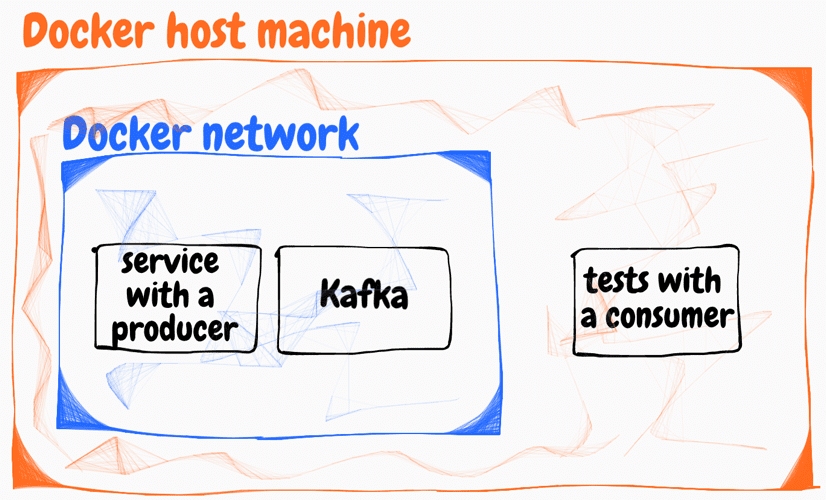Deploy a Kafka broker in a Docker container
This tutorial provides a step-by-step instruction on how to deploy a Kafka broker with Docker containers when a Kafka producer and consumer sit on different networks.
As a part of our recent Kaa enhancement we needed to deploy one of our newly created Kaa services together with a Kafka server in Docker containers and test it from a host machine. The service played the role of a Kafka producer and tests on the host machine were a Kafka consumer. Therefore, both the producer and the Kafka broker sit inside the Docker network while the consumer was on the outside. It looks like this:

This is how we did it: The first thing to do is go to the Docker Hub and find a Kafka Docker image. We used Wurstmeister Kafka and ZooKeeper images. Define the first draft of the Docker Compose file:
version: '2' services: zookeeper: image: wurstmeister/zookeeper:3.4.6 expose: - "2181" kafka: image: wurstmeister/kafka:2.11-2.0.0 depends_on: - zookeeper ports: - "9092:9092" environment: KAFKA_ADVERTISED_LISTENERS: PLAINTEXT://localhost:9092 KAFKA_LISTENERS: PLAINTEXT://0.0.0.0:9092 KAFKA_ZOOKEEPER_CONNECT: zookeeper:2181
Bootstrap the above Compose file and use
kafka-console-producer.sh and kafka-console-consumer.sh
utilities from the Quickstart section of the Apache Kafka site.
The result of running the producer from the Docker host machine:
andrew@host$ bin/kafka-console-producer.sh --broker-list localhost:9092 --topic test >Hi there! >It is a test message.
The result of running the consumer:
andrew@host$ bin/kafka-console-consumer.sh --bootstrap-server localhost:9092 --topic test --from-beginning Hi there! It's a test message.
As you can see, everything works just fine when both producer and
consumer are in one network.
Pay attention to the KAFKA_ADVERTISED_LISTENERS environment variable from the
above Compose file.
Kafka sends the value of this variable to clients during their connection.
After receiving that value, the clients use it for sending/consuming records to/from the
Kafka broker.
Since we defined the variable as PLAINTEXT://localhost:9092, both producer and consumer received it on the initial
connection
and used it for further communication with the broker through the forwarded 9092
port.

The key takeaway here is that clients use the specified Kafka address (the values of
--bootstrap-server and --broker-list) only for the initial
connection.
Kafka then redirects them to the value specified in the
KAFKA_ADVERTISED_LISTENERS variable, which the clients then use for
producing/consuming records.
Let's run the producer inside an arbitrary Docker container within the same Docker network where
the Kafka container is running.
root@869f83f2f265:/kafka# bin/kafka-console-producer.sh --broker-list localhost:9092 --topic test >Hi there! [2018-10-10 14:37:40,397] WARN [Producer clientId=console-producer] Connection to node -1 could not be established. Broker may not be available. (org.apache.kafka.clients.NetworkClient)
No way - we immediately receive the error message about the failed operation.
What happened here is the client received the value of the KAFKA_ADVERTISED_LISTENERS
environment variable (PLAINTEXT://localhost:9092), then tried to connect to it and failed since
there is no such resolvable address inside the client's Docker container.
It is clear that from the client perspective the Kafka is reachable on kafka:9092
address.
Therefore, in order for the client to be able to communicate with the broker, the KAFKA_ADVERTISED_LISTENERS
value must be set to PLAINTEXT://kafka:9092.
Back to our Docker Compose file:
kafka: image: wurstmeister/kafka:2.11-2.0.0 depends_on: - zookeeper ports: - "9092:9092" environment: KAFKA_ADVERTISED_LISTENERS: PLAINTEXT://kafka:9092 KAFKA_LISTENERS: PLAINTEXT://0.0.0.0:9092 KAFKA_ZOOKEEPER_CONNECT: zookeeper:2181
root@7dfb9eaa81dc:/kafka# bin/kafka-console-producer.sh --broker-list kafka:9092 --topic test >Hi there!
Cool! Now we managed to publish records to the Kafka inside the Docker container.
Note: the container with the client must be in the same Docker
network as the Kafka broker. Otherwise, kafka:9092 won't be resolvable.
Let's try to consume the published message by the consumer from the Docker host machine:
andrew@host$ bin/kafka-console-consumer.sh --bootstrap-server kafka:9092 --topic test --from-beginning [2018-10-10 23:57:06,827] WARN Removing server kafka:9092 from bootstrap.servers as DNS resolution failed for kafka (org.apache.kafka.clients.ClientUtils)
As expected, the consumer has failed to connect to the broker since kafka:9092
is not resolvable from the host machine.
We need to make some changes to the above Compose file.
kafka: image: wurstmeister/kafka:2.11-2.0.0 depends_on: - zookeeper ports: - "9092:9092" expose: - "9093" environment: KAFKA_ADVERTISED_LISTENERS: INSIDE://kafka:9093,OUTSIDE://localhost:9092 KAFKA_LISTENER_SECURITY_PROTOCOL_MAP: INSIDE:PLAINTEXT,OUTSIDE:PLAINTEXT KAFKA_LISTENERS: INSIDE://0.0.0.0:9093,OUTSIDE://0.0.0.0:9092 KAFKA_ZOOKEEPER_CONNECT: zookeeper:2181 KAFKA_INTER_BROKER_LISTENER_NAME: INSIDE
Let's explore some of the above environment variables:
- KAFKA_ADVERTISED_LISTENERS - the list of available addresses that
points to the Kafka broker. Kafka will send them to clients on their initial
connection.
- KAFKA_LISTENERS - the list of addresses (0.0.0.0:9093,
0.0.0.0:9092) and listener names (INSIDE,
OUTSIDE) on which Kafka broker will listen on for incoming connections.
- KAFKA_LISTENER_SECURITY_PROTOCOL_MAP - maps the defined above listener
names (INSIDE, OUTSIDE) to the PLAINTEXT Kafka
protocol.
- KAFKA_INTER_BROKER_LISTENER_NAME - points to a listener name that will
be used for cross-broker communication.
Here we defined two listeners (INSIDE://0.0.0.0:9093, OUTSIDE://0.0.0.0:9092)
for internal traffic within the Docker network and external traffic from the Docker host
machine respectively.
We specified the INSIDE listener for the cross-broker communication.
By means of KAFKA_ADVERTISED_LISTENERS and KAFKA_LISTENER_SECURITY_PROTOCOL_MAP
we instructed Kafka to send PLAINTEXT://kafka:9093 to those clients that come to it
on kafka:9093
and PLAINTEXT://localhost:9092 to those who come on localhost:9092.
In short, we defined the two types of Kafka clients - external and internal - and configured Kafka to send them different addresses on their initial connections.
Now run the producer within the Docker network:
root@7dfb9eaa81dc:/kafka# bin/kafka-console-producer.sh --broker-list kafka:9093 --topic test >Hi there!
And the consumer from the Docker host machine:
andrew@host$ bin/kafka-console-consumer.sh --bootstrap-server localhost:9092 --topic test --from-beginning Hi there!
Let's depict both client types for clarity.
The producer and the Kafka broker are inside the Docker network.

The consumer is outside, the Kafka broker is inside the Docker network.

Now you know how to develop and test your services when they sit in different networks with your Kafka server.
Andrew Pasika
Software Engineer






